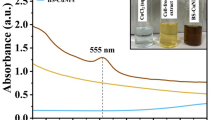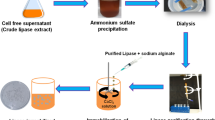Abstract
Parasporal inclusion protein of Bacillus thuringiensis-LDC-501 (Bt-LDC-501) exhibits selective cytocidal action towards human colon cancer cells. The yield of this parasporal protein was minimum in the normal culture. In order to increase the yield of protein from Bt-LDC-501 various agro-based cost-efficient nutrient sources such as corn steep liquor (CSL), sesame oil cake extract (SOC), groundnut oil cake extract (GOC), neem oil cake extract (NOC), rice bran extract (RB), wheat bran extract (WB), red gram hull extract (RGH), green gram hull extract (GGH), black gram hull extract (BGH), Mysore gram hull extract (MGH), and maize flour waste extract (MFW) were screened. Statistical experimental designs such as Plackett–Burman design (PBD) and response surface methodology (RSM) were the tools employed for the optimization of medium. Groundnut cake extract (GOC) served as a potential carbon and nitrogen source, as it induced twofold higher production of parasporal protein. Among the optimized seven media components KH2PO4, K2HPO4, GOC, NaCl, MgSO4, MnSO4, and FeSO4, the concentrations of GOC, NaCl, and MgSO4 have significant effect on parasporin production as well as cytotoxicity against colon cancer cell line, HCT-116. Bt-LDC-501 was found to produce 0.88 mg/ml of parasporal protein in optimized medium. In the un-optimized medium, the yield was 0.23 mg/ml only. This indicated that there was 382% of increase in the production of Parasporal protein. Parasporin protein with the molecular weight of 27 kDa has been purified with the purification fold of 27.1. It showed a LC50 value of 0.91 and 1.21 µg/ml against colorectal cancer cell lines such as HCT-116 and HCT-15, respectively. Purified parasporin exhibited stable cytocidal activity between pH 4.0 and 9.0 at room temperature. The present study revealed that the quantity and quality of media composition were necessary for eliciting cytocidal activity against human colon cancer and the importance of alternate cost-effective production of clinically significant parasporin. Moreover, this is the first report regarding optimization of media components for parasporal protein production from Bt.




Similar content being viewed by others
References
Abdel-Hameed A (2001) Stirred tank culture of Bacillus thuringiensis H-14 for production of the mosquitocidal δ-endotoxin: mathematical modelling and scaling-up studies. World J Microbiol Biotechnol 17:857–861
Amin G, Alotaibi S, Youssef NA, Saleh WD (2008) Optimization of a fermentation process for bioinsecticide production by Bacillus thuringiensis. World J Microbiol Biotechnol 24:2465
Anagnostopoulos C, Spizizen J (1961) Requirements for transformation in Bacillus subtilis. J Bacteriol 81:741–746
Chang M, Zhou S-G, Lu N, Ni J-R (2008) Starch processing wastewater as a new medium for production of Bacillus thuringiensis. World J Microbiol Biotechnol 24:441–447
Hapon M, Hapon M, Persia F, Pochettino A, Lucero G (2014) Aqueous extract of Prosopis strombulifera (LAM) Benth induces cytotoxic effects against tumor cell lines without systemic alterations in BALB/c mice. J Clin Toxicol 4(2161–0495):1000222
Hayakawa T, Kanagawa R, Kotani Y, Kimura M, Yamagiwa M, Yamane Y, Takebe S, Sakai H (2007) Parasporin-2Ab, a newly isolated cytotoxic crystal protein from Bacillus thuringiensis. Curr Microbiol 55:278–283
Infante I, Morel MA, Ubalde MC, Martínez-Rosales C, Belvisi S, Castro-Sowinski S (2010) Wool-degrading Bacillus isolates: extracellular protease production for microbial processing of fabrics. World J Microbiol Biotechnol 26:1047–1052
Jung YC, Mizuki E, Akao T, Cote JC (2007) Isolation and characterization of a novel Bacillus thuringiensis strain expressing a novel crystal protein with cytocidal activity against human cancer cells. J Appl Microbiol 103:65–79
Karpiński TM, Szkaradkiewicz AK (2013) Anticancer peptides from bacteria. Bangladesh J Pharmacol 8(3):343–348
Katayama H, Yokota H, Akao T, Nakamura O, Ohba M, Mekada E, Mizuki E (2005) Parasporin-1, a novel cytotoxic protein to human cells from non-insecticidal parasporal inclusions of Bacillus thuringiensis. J Biochem 137:17–25
Keshavarzi M, Salimi H, Mirzanamadi F (2005) Biochemical and physical requirements of Bacillus thuringiensis subsp. kurstaki for high biomass yield production. J Agric Sci Technol 7:41–47
Laemmli UK (1970) Cleavage of structural proteins during the assembly of the head of bacteriophage T4. Nature 227:680–685
Mizuki E, Ohba M, Akao T, Yamashita S, Saitoh H, Park YS (1999) Unique activity associated with non-insecticidal Bacillus thuringiensis parasporal inclusions: in vitro cell-killing action on human cancer cells. J Appl Microbiol 86:477–486
Mizuki E, Park YS, Saitoh H, Yamashita S, Akao T, Higuchi K, Ohba M (2000) Parasporin, a human leukemic cell-recognizing parasporal protein of Bacillus thuringiensis. Clin Diagn Lab Immunol 7:625–634
Moazamian E, Bahador N, Azarpira N, Rasouli M (2018) Anti-cancer parasporin toxins of new Bacillus thuringiensis against human colon (HCT-116) and blood (CCRF-CEM) cancer cell lines. Curr Microbiol 75:1090–1098
Mounsef JR, Salameh D, Awad M, Brandam C, Lteif R (2014) Evaluation of a cereal milling by-product for the low cost production of Bacillus thuringiensis kurstaki in submerged fermentation. Eur J Biotechnol Biosci 1:10–16
NCI (2012) National Cancer Institute. https://www.cancer.gov/cancertopics/types/colon-and-rectal
Okassov A, Nersesyan A, Kitada S, Ilin A (2015) Parasporins as new natural anticancer agents: a review. J BUON 20(1):5
Okumura S, Saitoh H, Wasano N, Katayama H, Higuchi K, Mizuki E, Inouye K (2006) Efficient solubilization, activation, and purification of recombinant Cry45Aa of Bacillus thuringiensis expressed as inclusion bodies in Escherichia coli. Protein Expr Purif 47:144–151
Okumura S, Saitoh H, Ishikawa T, Mizuki E, Inouye K (2008) Identification and characterization of a novel cytotoxic protein, parasporin-4, produced by Bacillus thuringiensis A1470 strain. Biotechnol Annu Rev 14:225–252
Ozkan M, Dilek FB, Yetis U, Ozcengiz G (2003) Nutritional and cultural parameters influencing antidipteran delta-endotoxin production. Res Microbiol 154:49–53
Patil SR, Amena S, Vikas A, Rahul P, Jagadeesh K, Praveen K (2013) Utilization of silkworm litter and pupal waste-an eco-friendly approach for mass production of Bacillus thuringiensis. Biores Technol 131:545–547
Periyasamy A, Kkani P, Chandrasekaran B, Ponnusamy S, Viswanathan S, Selvanayagam P, Rajaiah S (2016) Screening and characterization of a non-insecticidal Bacillus thuringiensis strain producing parasporal protein with selective toxicity against human colon cancer cell lines. Ann Microbiol 66:1167–1178
Poornima K, Selvanayagam P, Shenbagarathai R (2010) Identification of native Bacillus thuringiensis strain from South India having specific cytocidal activity against cancer cells. J Appl Microbiol 109:348–354
Poornima K, Saranya V, Abirami P, Binuramesh C, Suguna P, Selvanayagam P, Shenbagarathai R (2012) Phenotypic and genotypic characterization of B.t.LDC-391 strain that produce cytocidal proteins against human cancer cells. Bioinformation 8:461–465
Siegel R, Naishadham D, Jemal A (2012) Cancer statistics, 2012. Cancer J Clin 62(1):10–29
Switzer RC 3rd, Merril CR, Shifrin S (1979) A highly sensitive silver stain for detecting proteins and peptides in polyacrylamide gels. Anal Biochem 98:231–237
Teimoori-Toolabi L, Azadmanesh K, Khorramizadeh M, Hashemi S (2014) Abstract 3769: K-ras silencing has diverse effect on the response of cells to chemotherapeutic drugs. Can Res 74:3769–3769
Timothy JY (2001) Colon cancer; University of South Florida, Encyclopaedia of life Sciences, Nature Publishing Group, 1–2 Tropical Botanical Gardens
Uemori A, Ohgushi A, Yasutake K, Maeda M, Mizuki E, Ohba M (2008) Parasporin-1Ab, a novel Bacillus thuringiensis cytotoxin preferentially active on human cancer cells in vitro. Anticancer Res 28:91–95
Vidyarthi AS, Tyagi RD, Valero JR, Surampalli RY (2002) Studies on the production of B. thuringiensis based biopesticides using wastewater sludge as a raw material. Water Res 36:4850–4860
Yasutake K, Binh ND, Kagoshima K, Uemori A, Ohgushi A, Maeda M, Mizuki E, Yu YM, Ohba M (2006) Occurrence of parasporin-producing Bacillus thuringiensis in Vietnam. Can J Microbiol 52:365–372
Yezza A, Tyagi RD, Valéro JR, Surampalli RY (2005) Wastewater sludge pre-treatment for enhancing entomotoxicity produced by Bacillus thuringiensis var kurstaki. World J Microbiol Biotechnol 21:1165
Zaid AA, El-Shenawy NS (2010) Effect of miso (A soybean fermented food) on some human cell lines; HEPG2, MCF7 and HCT116. J aAm Sci 6:1274–1282
Zambare VP, Nilegaonkar SS, Kanekar PP (2007) Production of an alkaline protease by Bacillus cereus MCM B-326 and its application as a dehairing agent. World J Microbiol Biotechnol 23:1569–1574
Acknowledgements
The authors thank the DBT-BIF (BT/BI/25/001/2006 (Vol.-II)) and DST-SERB with the reference number of SR/SO/HS/0116/2012 for financial support. The authors thank Dr. Poornima and Dr. Abirami for providing their strains from our departmental collection, Lady Doak College, Madurai and for their technical support.
Author information
Authors and Affiliations
Corresponding author
Ethics declarations
Conflict of interest
There is no conflict of interest.
Additional information
Publisher's Note
Springer Nature remains neutral with regard to jurisdictional claims in published maps and institutional affiliations.
Rights and permissions
About this article
Cite this article
Grace, J.J., Ramani, G. & Shenbagarathai, R. Enhancement of Purified Human Colon Cancer-Specific Parasporal Toxin from Bacillus thuringiensis-LDC-501. Curr Microbiol 77, 104–114 (2020). https://doi.org/10.1007/s00284-019-01800-x
Received:
Accepted:
Published:
Issue Date:
DOI: https://doi.org/10.1007/s00284-019-01800-x




